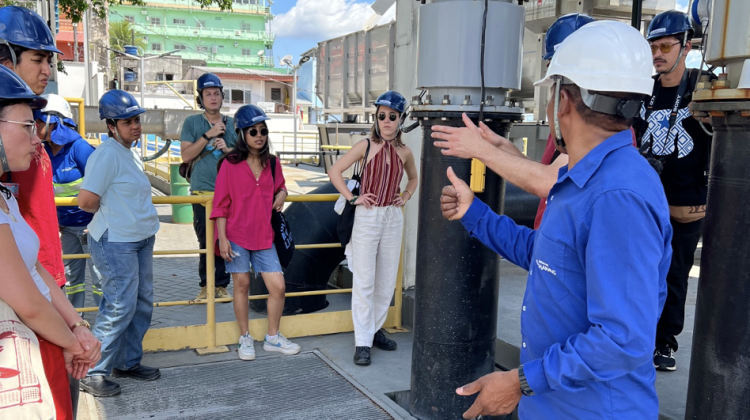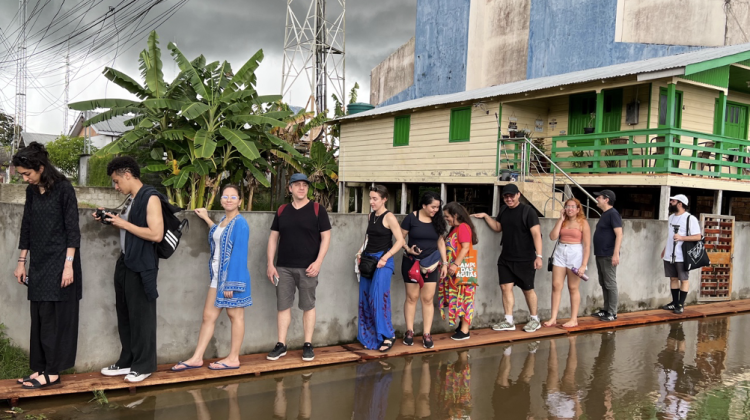Cities and towns within the Amazon region of South America are growing more rapidly than any other metropolitan area within the continent, hitting population growth rates of 20% over the past decade. In many of the Amazon region’s cities impacted by this population growth, solid waste and untreated wastewater has increased and subsequently accumulated in riverways and canals in cities' urban cores. Leveraging a five-year relationship with Professor Marcos Cereto from the Federal University of Manaus (UFAM) and Professor Alexandre Delijaicov from the University of São Paulo (USP), students enrolling in a new class, Architectural Design Workshop — The Fluvial Amazonian City: Manaus 2025, with Professor Angelo Bucci (Architecture) and Professor Gabriella Carolini (DUSP) traveled to the major Amazonian urban center of Manaus, Brazil this July. Manaus, the seventh-largest city in Brazil, is located in the center of the Amazonian rainforest near the meeting point of the Solimões and Negro rivers, which then form the Amazon River. The class seeks to engage graduate students in the design and planning of more resilient housing and sanitation in the growing urban environments of the Amazon biosphere.
Participants in the class aim to provoke a shift in the design thinking and planning in Manaus by recentering the city’s waterways as a key resource for the vitality of urban life. Earlier decades in Manaus saw the city’s rivers and canals as core community spaces, with recreation, mobility, and cultural functions. Students enrolled in the class are working to help reignite the affective memory of those earlier river and landscapes, a memory that remains alive among residents despite of the destruction of the natural landscape and water pollution. During their July field work period, MIT students partnered with architecture and planning students from UFAM and USP to document the local context, learn from local knowledge resources—including Indigenous leaders in Brazil’s first urban Indigenous community—Parque das Tribos, archeologists and architects working at the Museum of Amazonia (MUSA), the major private water and sanitation concessionaire, Águas de Manaus, and many others to begin ideation and iteration of novel design and planning proposals around the themes of resilient housing and sustainable sanitation systems.
A selection of the final class proposals will be featured in an exhibit in the Inter-American Development Bank’s pavillion in COP 30 in Belem this November 2025.
The class work and partnership with UFAM and USP is generously sponsored by the Inter-American Development Bank’s City Lab, as well as grants from the Leventhal Center for Advanced Urbanism and the Department of Urban Studies and Planning.
MIT graduate students from Architecture and DUSP included: Marine Gapihan (DUSP), Jacob Payne (Architecture), Shreya Bansal (DUSP), Kaede Polkinghorne (DUSP), Reishan McIntosh (Architecture), Valeria Duenas (Architecture), Aashna Daga (Architecture), and Anushka Maqbool (DUSP).
Partners from UFAM and USP included: Juliana de Oliveira Cambeiro (UFAM), Alex Martins Almeida (UFAM), Eliana Rego Santos (UFAM), Mariana Normando Pereira (UFAM), Giovanna Barbosa de Assis (UFAM), Nathyele de Souza Dias (UFAM), Maria Eduarda Picanço Cohen (UFAM), Ester Cavalcante de Oliveira Komorowski (UFAM), Isabella de Bonis (UFAM and USP), Lucas Karmann (USP), Ana Julia Bettio Pereira (USP), and Professor Rodrigo Mendes de Souza (USP and Universidade Federal de Mato Grosso do Sul).





